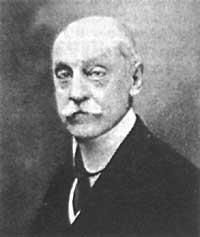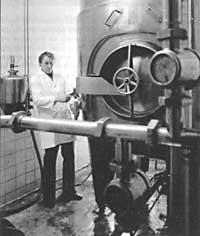Phoebus Levene and Robert Hadfield
1990/09/01 Azkune Mendia, Iñaki - Elhuyar Fundazioa Iturria: Elhuyar aldizkaria
Phoebus Aaron Theodor LEVENE was born on 25 February 1869 in the Russian town of Sagor in a family of Jews. At first it was called Fishel Aaronovitx Levin and when his family moved to Saint Petersburg (present-day Leningrad), it was called Fyodor. However, when he emigrated to the United States in 1891 he began to use the name Phoebus.
...
Levene was studying medicine, but emigration interrupted his career. However, he returned from the United States to Russia to finish his studies. When he obtained the medical title, in 1892 he returned to the United States.

Working as a doctor, he began studying chemistry at Columbia University. When he left the medicine, he wanted to go deeper into chemistry and to do so he went to Germany to study with Emil Fischer and Albrecht Kossel. As a result of Kossel he took care of nucleic acids, becoming the central theme of his life.
Leven isolated and identified the carbohydrate part of the nucleic acid molecule, surprising Kossel himself. In 1909 he showed that the sugar of five carbon atoms (ribose) was only found in some nucleic acids. In 1929, for its part, it showed that another unknown sugar existed in several nucleic acids. The unknown sugar was deoxyribose, with an atom less of oxygen.
In nucleic acid no other type of sugar has yet been found, so these acids are classified into two groups: ribonucleic acid and deoxyribonucleic acid, depending on the type of sugar they contain. They are known with RNA and DNA abbreviations and cannot be denied that they are better known in biochemistry than any other.
Leven discovered how the components of nucleic acids were combined to form nucleotides. The nucleotides are catalysts of the long nucleic acid molecule and Leven discovered how the nucleotides join to form these long chains.
Levene, a biochemist, died on September 6, 1940, in New York City.
Robert Abbott HADFIELD first saw the light of this world in the English city of Sheffield on November 29, 1858. Sheffield was then the capital of iron and steel. Therefore, it is no surprise that Hadfield attempts to improve steel.
If the manganese was added to the steel, it became fragile, but Hadfield threw more than it suited for the metallurgists at the time. When the steel contained a twelve percent manganese, in addition, it did not become fragile.
Hadfield discovered other features of this unique manganese steel. When the steel was heated to a thousand degrees and cooled sharply in the water (when tempered), the hardness gained a lot. Accordingly, this tempered steel could be used for working other metals and drilling stones. They lasted thirty times longer than steel tools for rail manufacturing.

Hadfield patented this type of steel in 1883 and then tested other metals in steel alloys to obtain interesting properties. Molybdenum, vanadium, chromium, tungsten, etc. He used them.
In 1913 Hadfield began manufacturing stainless steels mixing chromium and nickel to steel. After a long time they realized that these alloys were kept bright even without oxidizing themselves by outside rain.
Since then, the sector of the alloy steels has spread notably due to the large number of different steels and the diversity of uses that have been given. But we must not forget that Hadfield's contribution has been decisive.
In 1908 he was given the title of Sir and in 1917 the title of Baron. He participated in the Royal Society of London and published numerous metallurgy works. The book Metallurgy and its influence on modern progress, published in 1925, has become a classic.
Metallurgical Hadfield died fifty years ago in London, on September 30, 1940.

Gai honi buruzko eduki gehiago
Elhuyarrek garatutako teknologia




